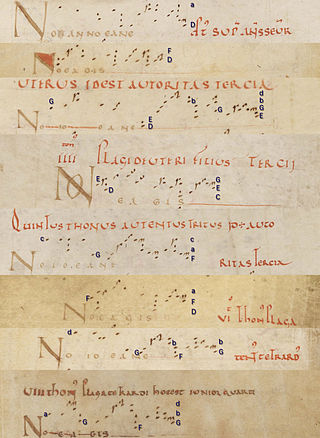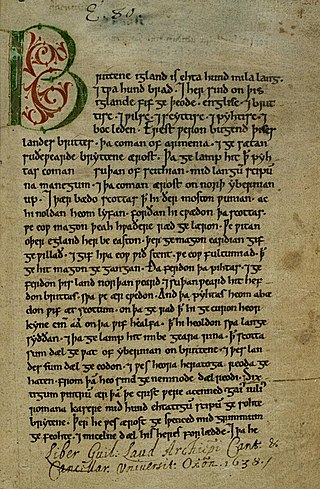Related Research Articles

The Bibliothèque nationale de France is the national library of France, located in Paris on two main sites known respectively as Richelieu and François-Mitterrand. It is the national repository of all that is published in France. Some of its extensive collections, including books and manuscripts but also precious objects and artworks, are on display at the BnF Museum on the Richelieu site.

Adémar de Chabannes was a French/Frankish monk, active as a composer, scribe, historian, poet, grammarian and literary forger. He was associated with the Abbey of Saint Martial, Limoges, where he was a central figure in the Saint Martial school, an important center of early medieval music. Much of his career was spent copying and transcribing earlier accounts of Frankish history; his major work was the Chronicon Aquitanicum et Francicum.

Bertrada of Laon, also known as Bertrada the Younger or Bertha Broadfoot, was a Frankish queen. She was the wife of Pepin the Short and the mother of Charlemagne, Carloman and Gisela, plus five other children.

Froissart's Chronicles are a prose history of the Hundred Years' War written in the 14th century by Jean Froissart. The Chronicles open with the events leading up to the deposition of Edward II in 1327, and cover the period up to 1400, recounting events in western Europe, mainly in England, France, Scotland, the Low Countries and the Iberian Peninsula, although at times also mentioning other countries and regions such as Italy, Germany, Ireland, the Balkans, Cyprus, Turkey and North Africa.

Girart de Roussillon, also called Girard, Gérard II, Gyrart de Vienne, and Girart de Fraite, was a Frankish Burgundian leader who became Count of Paris in 837, and embraced the cause of Lothair I against Charles the Bald. He was a son of Leuthard I, Count of Fézensac and Paris, and his wife Grimildis.
The Chronicle of the Kings of Alba, or Scottish Chronicle, is a short written chronicle covering the period from the time of Kenneth MacAlpin until the reign of Kenneth II. W.F. Skene called it the Chronicle of the Kings of Scots, and some have called it the Older Scottish Chronicle, but Chronicle of the Kings of Alba is emerging as the standard scholarly name.

The Grandes Chroniques de France is a vernacular royal compilation of the history of the Kingdom of France, most manuscripts of which are luxury copies that are heavily illuminated. Copies were produced between the thirteenth and fifteenth centuries, the text being extended at intervals to cover recent events. It was first compiled in the reign of Saint Louis, who wished to preserve the history of the Franks, from the coming of the Trojans to his own time, in an official chronography whose dissemination was tightly controlled. It was continued under his successors until completed in 1461. It covers the Merovingian, Carolingian, and Capetian dynasties of French kings, with illustrations depicting personages and events from virtually all their reigns.

David Aubert was a French calligrapher who transcribed and adapted courtly romances and chronicles for the court of the Duke of Burgundy. In addition to finely presented works, illuminated at Bruges and other centres, for the Dukes Philip the Good and Charles the Bold and the Duchess Margaret of York, he completed manuscripts for Antoine de Bourgogne and Philippe de Croy.
Philippe Mouskes was the author of a rhymed chronicle that draws on the history of the Franks and France, from the origins until 1242.

Lu rebellamentu di Sichilia, fully Cronica di lu rebellamentu di Sichilia contra re Carlu, is a Sicilian historical chronicle of the War of the Vespers written around 1290. The anonymous Rebellamentu, probably written at Messina, was ascribed to Atanasiu di Iaci by Pasquale Castorina in 1883. Though the Rebellamentu sometimes adds valuable details to the history of the Vespers, it is frequently untrustworthy. Its monastic provenance is evident in its moralising tone. The antiquity of its language has placed its authenticity beyond doubt, despite its lack of an early manuscript tradition. This has not prevented speculation that it was written contemporarily with events: one verb in one manuscript is found in the first-person present; this may represent the author inadvertently stepping out of his usual frame of reference, or merely an error in that manuscript.

The Liber instrumentorum memorialium is the surviving cartulary of the Lords of Montpellier, the Guilhems (Guillems), and an important source for their history. It was compiled in the early thirteenth century, under the patronage of William VIII, whose lordship is extensively catalogued in it. Its earliest documents date to 1059; its latest to 1204. Its 570 instruments are organised by both type and geography. According to the cartulary's preface, the documents are of two main types: those dealing with the lord's possessions in the Diocese of Maguelonne and those dealing with his possessions elsewhere. Of these 150 record oaths of various sorts, while only 30 are convenientia (conventions). The earliest documents record some agreements of William IV involving the castles of Pouget and Saint-Pons-de-Mauchiens in 1059. The last few documents record the brief independent rule of William VIII's daughter Mary before her marriage to Peter the Catholic brought the lordship into the Crown of Aragon.

The Annales laureshamenses, also called Annals of Lorsch (AL), are a set of Reichsannalen that cover the years from 703 to 803, with a brief prologue. The annals begin where the "Chronica minora" of the Anglo-Saxon historian Bede leaves off—in the fifth year of the Emperor Tiberios III—and may have originally been composed as a continuation of Bede. The annals for the years up to 785 were written at the Abbey of Lorsch, but are dependent on earlier sources. Those for the years from 785 onward form an independent source and provide especially important coverage of the imperial coronation of Charlemagne in 800. The Annales laureshamenses have been translated into English.

The Anglo-Saxon Chronicle is a collection of annals in Old English, chronicling the history of the Anglo-Saxons.

The Talbot Shrewsbury Book is a very large richly-illuminated manuscript made in Rouen (Normandy) in 1444/5. It was presented by John Talbot, 1st Earl of Shrewsbury to the French princess, Margaret of Anjou, in honour of her betrothal to King Henry VI. It contains a unique collection of fifteen texts in French, including chansons de geste, chivalric romances, treatises on warfare and chivalry, and finally the Statutes of the Order of the Garter. The work is an excellent example of book production in Rouen in the mid-fifteenth century and provides a rare insight into the political views of the English military leader and close confidant of the crown, John Talbot.

The Codex Parisino-Petropolitanus (CPP) is one of the oldest extant manuscripts of the Quran, attributed to the 7th century.

Leidrad was the bishop of Lyon from 797 and its first archbishop from 804 until 814. He was a courtier of Charlemagne before he was a bishop. As bishop, he helped resolve the adoptionist controversy. He also began a programme of building and renovation in his diocese, turning Lyon into a centre of learning. Of his writings, two letters and a treatise on baptism survive.

Primat was a French Benedictine monk and historian of the abbey of Saint-Denis near Paris. He composed two histories of France with a royal focus, one in Latin and the other in Old French. His Latin chronicle covers the years 1248 to 1277 but now survives only in an Old French translation and in excerpts incorporated into the works of others. It contains a detailed account of the reign of Louis IX, making it one of the most important contemporary sources for that reign. His French chronicle, the Roman des rois, covers the entire history of France down to 1223. It was completed around 1274 for Philip III and its presentation copy is extant. It is the earliest version of what would become the Grandes Chroniques de France, the first official history of France.
The Annales Tiliani are an anonymous set of Latin annals from the Frankish kingdom, covering the years 708–807. They are considered minor annals.

Jean Chartier was a French chronicler and monk of the Abbey of Saint-Denis known for his chronicle of Charles VII.
References
- ↑ Jeffrey S. Widmayer, "The Chronicle of Montpellier H119: Text, Translation and Commentary," The Medieval Chronicle IV, ed. Erik Kooper (Rodopi, 2006), 233.
- ↑ Cf. the Annales Flores and Annales Paulini .
- ↑ Le petit Thalamus also contains the final written version (1204/5) of the Coutumes de Montpellier, based on those given Lord William VIII just before his death in 1202.
- ↑ Widmayer, 231.
- ↑ Widmayer, 232.
- ↑ An inherent error in the anno domini system means, however, that it was not exactly 814 years after Christ's birth either, but this error was unknown in the Middle Ages.